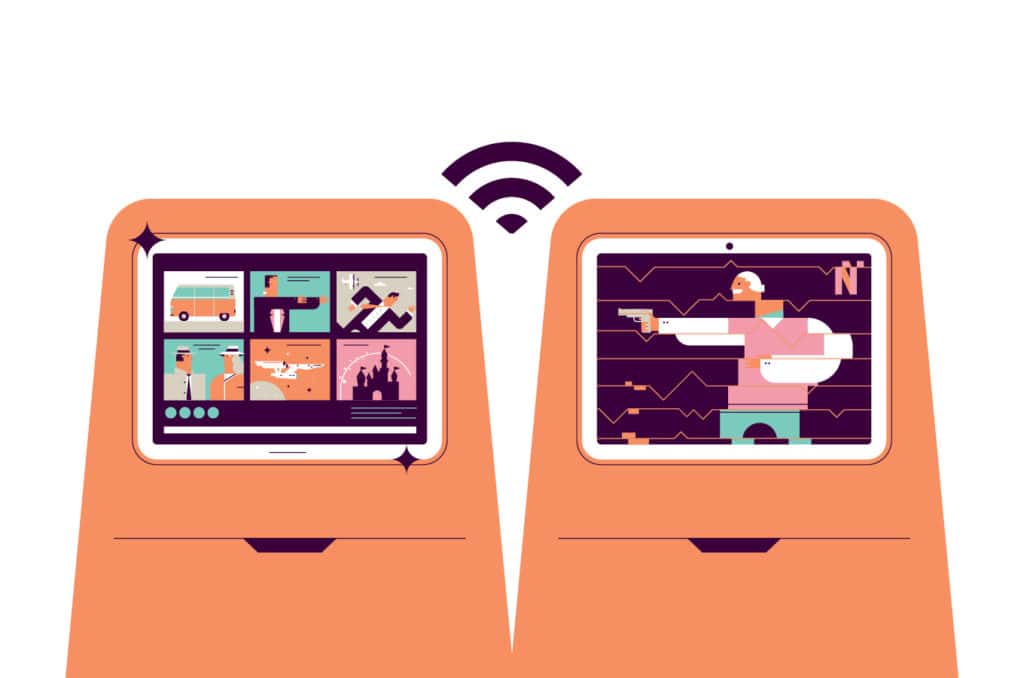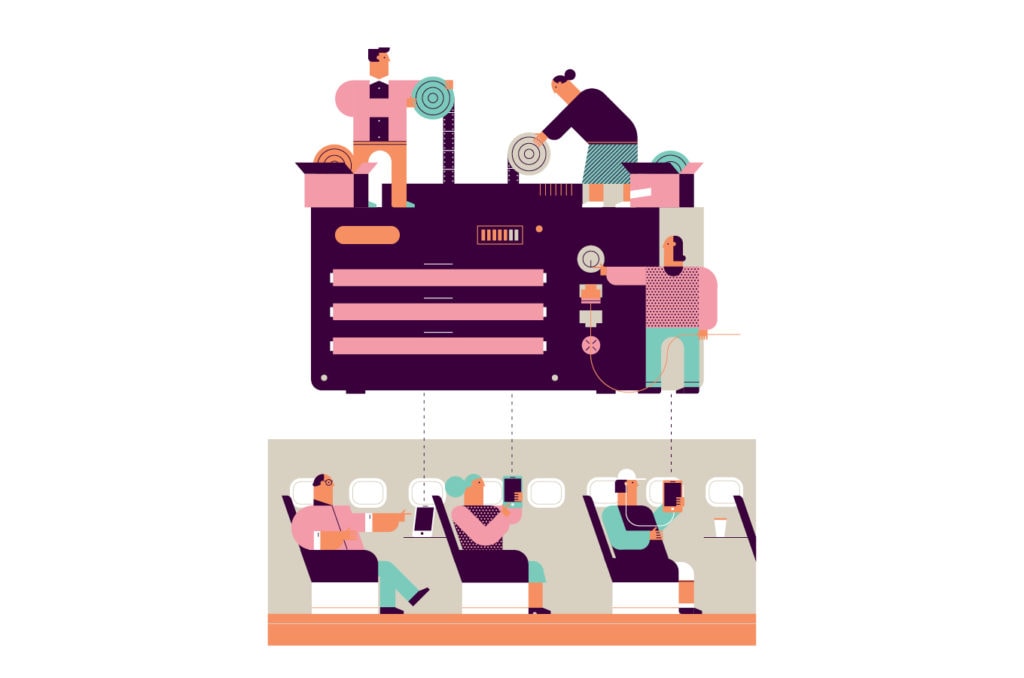APEX Insight: Widely considered the middlemen of the IFE industry, CSPs are evolving to embrace new and diverging technologies, keep pace with consumer tendencies and ensure that they don’t get squeezed out.
The content service provider (CSP), as we know it today, came to maturity when airlines realized they were going to struggle to get across the technical complexities of delivering content in the correct format (and with the necessary languages, subtitles, edits and metadata) to an assortment of in-flight entertainment (IFE) systems, across large fleets of mixed aircraft. And as IFE hardware got more advanced – and capable of storing vast libraries of content on demand – the business of sourcing, screening and curating all that content, plus negotiating prices and rights, introduced yet another complexity airlines weren’t ready for.
CSPs opened labs, investing heavily in equipment and talent to handle an increasing deluge of technical work. They built teams of experts to source local and international content, reduce pricing and negotiate rights with content owners. By leveraging the volume across multiple airline customers, they were able to achieve economies of scale and add value for airlines and studios. And by working with brands and advertisers, they found ways to monetize IFE – or at least offset the cost – for airlines that wished to do so. But in recent years, the number of active players in this field has declined, due largely to consolidation.
Enter developments like onboard streaming, pre-download, in-flight connectivity and the concept of the seamless passenger journey, in which airlines seek to optimize every possible touchpoint from booking to the final destination – and today’s CSPs are left with all their primary tasks, and so much more.
Can they stay relevant, or even get ahead, in an era where pre-roll advertising doesn’t cut it for brands, where YouTubers have more fans than A-listers and broadband in the cabin is opening the door for a player like Netflix to walk in like it owns the place?

THE CHALLENGE: COMPLEXITY
“At the moment, our role as a CSP is the most complex it has ever been,” says Henry Gummer, vice-president of Entertainment, Spafax, in reference to the technology and delivery ecosystem for airline content. “Airlines look to CSPs to drill down into the process on a regular basis to see if improvements can be made. Because while we do manage extraordinary complexity on an ongoing basis, we cannot expect airlines to continue to fund that without showing that we are fully invested in reducing that complexity.”
Kate Groth, vice-president of Everything at West Entertainment, agrees. “The CSP today invests a lot of time into operational metadata and integration logistics,” she says. “Depending on the airline fleet makeup, delivering to multiple systems, with multiple software updates and tight deadlines, requires the utmost attention to detail working across all our partners.”
Automation is the holy grail. And to that end, Spafax recently held its first hackathon, where the CSP investigated how artificial intelligence could help tag and categorize content, or even flag issues for editing, such as controversial images or language, thus assisting in the metadata process.
West Entertainment, on the other hand, developed its WE by West platform to simplify airline servicing needs, offering a more transparent and central marketplace for airlines to manage, select and track all their needs. West built automation on the backend to offer greater customization for each airline profile, hardware system and configuration. “In a more streamlined environment, we can then refocus on brand, brand alliance and overall customer personalization,” says Groth.

THE CHALLENGE: CONNECTIVITY
Having invested millions of dollars in shiny new Wi-Fi, airlines seem to no longer require the CSP, now having the option to offer Netflix or another subscription streaming platform instead. But nearly every CSP out there is making the case for how and where it can add value to the connected in-flight experience.
“We’re investing in the infrastructure of the connected aircraft, as you’ve seen from our recently announced Telesat LEO [low Earth orbit] constellation partnership,” says Duncan Abell, Global Eagle’s vice-president of Creative. “There are just more and more opportunities to deliver entertainment to those aircraft. Whether ‘content service provider’ is the right term for that, we don’t know. But in terms of growth we see the market increasing.”
Gummer believes the CSP will be instrumental in driving passenger engagement with connectivity portals, bringing in new types of brand alliances to subsidize the service and possibly reducing data over-consumption by integrating attractive cached content with the connected experience.
“Understandably, many airlines are focused on delivering the basic connected service without concentrating on how connectivity can improve the experience for customers,” he says. “Who better to turn to than a CSP to come up with new ways to best drive engagement from an audience they’ve been entertaining for 25 years? We know the content landscape better than anyone else and we’re well-versed in driving brand partnerships, which will be key to this new model.”
“If you just replace your entertainment with Netflix, it ends there – you have no brand engagement.” – Henry Gummer, Spafax
Speaking of new models, Netflix has been bullish on the IFE market and made inroads with several international carriers. Having developed technology that encodes content to use a third less bandwidth, Netflix is hopeful airlines will build “a sustainable model” around low-cost or free in-flight Wi-Fi.
Even with this new tech, Gummer warns bandwidth constraint issues are likely to persist. There’s also the airline brand to consider. “If you just replace your entertainment with Netflix, it ends there – you have no brand engagement. You’re not providing a curated experience for passengers. You don’t have an opportunity to advertise around it and you can’t control it or understand how people are using it,” he says.
Abell suggests that the industry is going through a bit of a phase with these streaming-based platforms. At the end of the day, he’s not convinced they’ll be able to make a proposition robust enough, or tailored enough, for discerning airlines. “Once the spike goes, the airlines will probably come back and say: Can I have the widest curation of the best content available? And find themselves back in the same position of needing what we provide.”

THE CHALLENGE: DARK FLIGHTS
For many smaller airlines and charter-based operations, IFE hasn’t traditionally been a big consideration. It’s pretty difficult to put content on a plane without IFE hardware in place, and that’s why many CSPs are either selling low-cost IFE solutions, or partnering closely with system manufacturers to open up this market.
Inflight Dublin is among the CSPs offering a turnkey solution. “We have two clear units in our business,” explains CEO John White. “One is content services, the traditional CSP type work, and the second is software – mainly wireless software, but also the other services that can grow out of it.”
Hardware from Astronics forms the backbone of Inflight Dublin’s Everhub offering, but the company is also looking ahead, software wise, to develop new areas that will continue to evolve with the industry. “Of course, the engineers have to be happy with the hardware … [But] airlines don’t buy hardware, they buy a service, and the hardware is a means to that end,” says White. “Hardware is becoming commoditized with the cost of servers and WAPs [wireless access points] and everything else dropping. We’re in the service business; we look to enhance the passenger experience and add more potential revenue channels for all the stakeholders.”
“Airlines don’t buy hardware, they buy a service, and the hardware is a means to that end.”- John White, Inflight Dublin
Global Eagle has likewise found cause to “hardware up,” launching the Airconnect Go portable IFE solution (also supported by hardware from Astronics) earlier this year at Aircraft Interiors Expo. Speaking to APEX Media at the launch, Michael Pigott, the company’s senior vice-president of Product and Portfolio, said, “Customers can rapidly receive our services while we’re doing our work to get full wireless IFE on board.”
Global Eagle says the system will roll out to its first customers by the end of this year, and that it will offer “mini-premium” options, whereby customers can subscribe to a content package and select some additional local content. “We are probably not going to get into embedded seats or compete with Thales and Panasonic, but you’ll see us expanding into more wireless IFE products. We’re also exploring alternative wireless IFE systems that can bridge the gap between our fully portable and premium experiences,” Pigott says.
West Entertainment has racked up 16 airline customers through its partnership with AirFi. “It’s a great solution,” says Groth of the portable streaming box from AirFi. “And that’s a stepping-stone to that next level of advertising, brand partnerships, pay-to-play and personalization.”
MOVING FORWARD: SERVICE AT ALL COSTS
So, what does the future look like for CSPs? It’s impossible to say definitively, but these innovators are certainly working all the angles. According to White, a big clue to that answer can be found right in the job title.
“We are a service provider,” he says. “We are in the business of service. To do that, you need to be very responsive, very agile, very flexible. If you’re that kind of business, then I think you’ll always succeed. The ability to change and adapt is inherent in the service business, and no matter what shape the industry takes, there will always be a place for that.”
“Who Needs a CSP?” was originally published in the 8.4 September/October issue of APEX Experience magazine.


